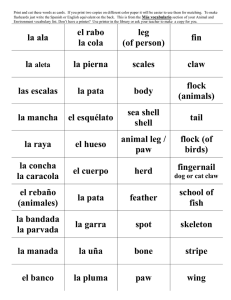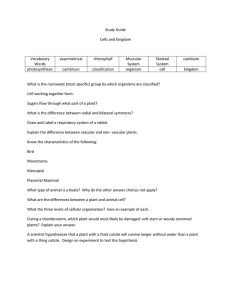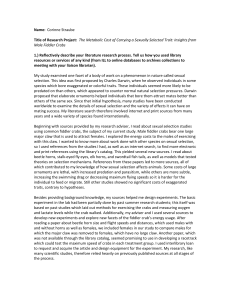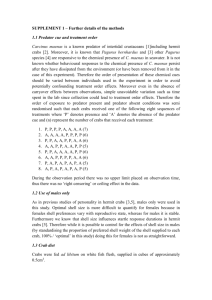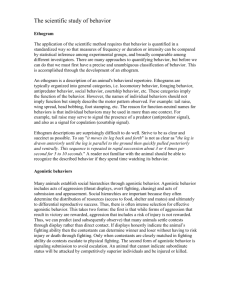Pushed to the Breaking Point:
advertisement
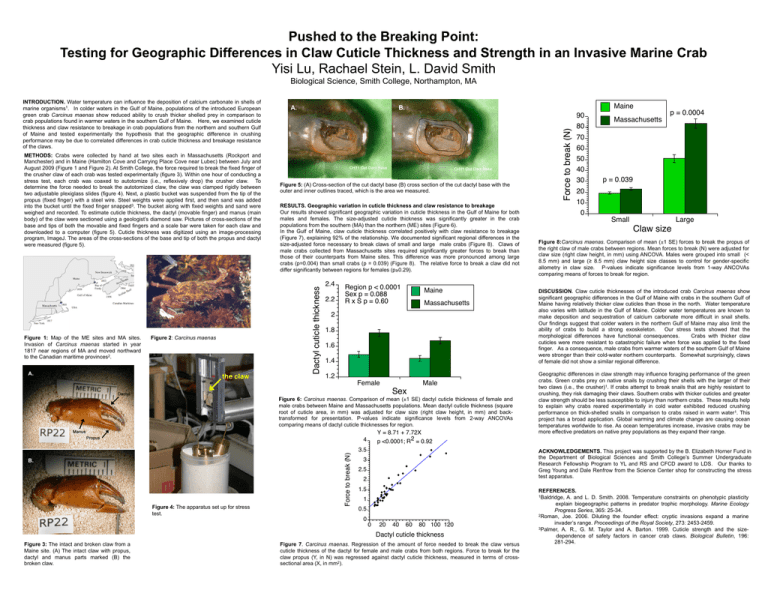
Pushed to the Breaking Point: Testing for Geographic Differences in Claw Cuticle Thickness and Strength in an Invasive Marine Crab Yisi Lu, Rachael Stein, L. David Smith Biological Science, Smith College, Northampton, MA Figure 1: Map of the ME sites and MA sites. Invasion of Carcinus maenas started in year 1817 near regions of MA and moved northward to the Canadian maritime provinces2. Figure 2: Carcinus maenas A. Maine B. Figure 5: (A) Cross-section of the cut dactyl base (B) cross section of the cut dactyl base with the outer and inner outlines traced, which is the area we measured. RESULTS. Geographic variation in cuticle thickness and claw resistance to breakage Our results showed significant geographic variation in cuticle thickness in the Gulf of Maine for both males and females. The size-adjusted cuticle thickness was significantly greater in the crab populations from the southern (MA) than the northern (ME) sites (Figure 6). In the Gulf of Maine, claw cuticle thickness correlated positively with claw resistance to breakage (Figure 7), explaining 92% of the relationship. We documented significant regional differences in the size-adjusted force necessary to break claws of small and large male crabs (Figure 8). Claws of male crabs collected from Massachusetts sites required significantly greater forces to break than those of their counterparts from Maine sites. This difference was more pronounced among large crabs (p=0.004) than small crabs (p = 0.039) (Figure 8). The relative force to break a claw did not differ significantly between regions for females (p≥0.29). 2.4 2.2 Region p < 0.0001 Sex p = 0.088 R x S p = 0.60 Maine Massachusetts 2 1.8 1.6 1.4 1.2 Female Male Sex Figure 6: Carcinus maenas. Comparison of mean (±1 SE) dactyl cuticle thickness of female and male crabs between Maine and Massachusetts populations. Mean dactyl cuticle thickness (square root of cuticle area, in mm) was adjusted for claw size (right claw height, in mm) and backtransformed for presentation. P-values indicate significance levels from 2-way ANCOVAs comparing means of dactyl cuticle thicknesses for region. Y = 8.71 + 7.72X 2 p <0.0001; R = 0.92 4 Figure 4: The apparatus set up for stress test. Force to break (N) 3.5 B. 90 80 70 60 50 40 30 20 10 0 Massachusetts p = 0.0004 p = 0.039 Small Large Claw size Figure 8:Carcinus maenas. Comparison of mean (±1 SE) forces to break the propus of the right claw of male crabs between regions. Mean forces to break (N) were adjusted for claw size (right claw height, in mm) using ANCOVA. Males were grouped into small (< 8.5 mm) and large (≥ 8.5 mm) claw height size classes to control for gender-specific allometry in claw size. P-values indicate significance levels from 1-way ANCOVAs comparing means of forces to break for region. DISCUSSION. Claw cuticle thicknesses of the introduced crab Carcinus maenas show significant geographic differences in the Gulf of Maine with crabs in the southern Gulf of Maine having relatively thicker claw cuticles than those in the north. Water temperature also varies with latitude in the Gulf of Maine. Colder water temperatures are known to make deposition and sequestration of calcium carbonate more difficult in snail shells. Our findings suggest that colder waters in the northern Gulf of Maine may also limit the ability of crabs to build a strong exoskeleton. Our stress tests showed that the morphological differences have functional consequences. Crabs with thicker claw cuticles were more resistant to catastrophic failure when force was applied to the fixed finger. As a consequence, male crabs from warmer waters of the southern Gulf of Maine were stronger than their cold-water northern counterparts. Somewhat surprisingly, claws of female did not show a similar regional difference. Geographic differences in claw strength may influence foraging performance of the green crabs. Green crabs prey on native snails by crushing their shells with the larger of their two claws (i.e., the crusher)1. If crabs attempt to break snails that are highly resistant to crushing, they risk damaging their claws. Southern crabs with thicker cuticles and greater claw strength should be less susceptible to injury than northern crabs. These results help to explain why crabs reared experimentally in cold water exhibited reduced crushing performance on thick-shelled snails in comparison to crabs raised in warm water1. This project has a broad application. Global warming and climate change are causing ocean temperatures worldwide to rise. As ocean temperatures increase, invasive crabs may be more effective predators on native prey populations as they expand their range. ACKNOWLEDGEMENTS. This project was supported by the B. Elizabeth Horner Fund in the Department of Biological Sciences and Smith College’s Summer Undergraduate Research Fellowship Program to YL and RS and CFCD award to LDS. Our thanks to Greg Young and Dale Renfrow from the Science Center shop for constructing the stress test apparatus. 3 2.5 2 1.5 1 0.5 0 0 20 40 60 80 100 120 Dactyl cuticle thickness Figure 3: The intact and broken claw from a Maine site. (A) The intact claw with propus, dactyl and manus parts marked (B) the broken claw. Force to break (N) METHODS: Crabs were collected by hand at two sites each in Massachusetts (Rockport and Manchester) and in Maine (Hamilton Cove and Carrying Place Cove near Lubec) between July and August 2009 (Figure 1 and Figure 2). At Smith College, the force required to break the fixed finger of the crusher claw of each crab was tested experimentally (figure 3). Within one hour of conducting a stress test, each crab was coaxed to autotomize (i.e., reflexively drop) the crusher claw. To determine the force needed to break the autotomized claw, the claw was clamped rigidly between two adjustable plexiglass slides (figure 4). Next, a plastic bucket was suspended from the tip of the propus (fixed finger) with a steel wire. Steel weights were applied first, and then sand was added into the bucket until the fixed finger snapped3. The bucket along with fixed weights and sand were weighed and recorded. To estimate cuticle thickness, the dactyl (movable finger) and manus (main body) of the claw were sectioned using a geologist’s diamond saw. Pictures of cross-sections of the base and tips of both the movable and fixed fingers and a scale bar were taken for each claw and downloaded to a computer (figure 5). Cuticle thickness was digitized using an image-processing program, ImageJ. The areas of the cross-sections of the base and tip of both the propus and dactyl were measured (figure 5). A. Dactyl cuticle thickness INTRODUCTION. Water temperature can influence the deposition of calcium carbonate in shells of marine organisms1. In colder waters in the Gulf of Maine, populations of the introduced European green crab Carcinus maenas show reduced ability to crush thicker shelled prey in comparison to crab populations found in warmer waters in the southern Gulf of Maine. Here, we examined cuticle thickness and claw resistance to breakage in crab populations from the northern and southern Gulf of Maine and tested experimentally the hypothesis that the geographic difference in crushing performance may be due to correlated differences in crab cuticle thickness and breakage resistance of the claws. Figure 7. Carcinus maenas. Regression of the amount of force needed to break the claw versus cuticle thickness of the dactyl for female and male crabs from both regions. Force to break for the claw propus (Y, in N) was regressed against dactyl cuticle thickness, measured in terms of crosssectional area (X, in mm2). REFERENCES. 1Baldridge, A. and L. D. Smith. 2008. Temperature constraints on phenotypic plasticity explain biogeographic patterns in predator trophic morphology. Marine Ecology Progress Series, 365: 25-34. 2Roman, Joe. 2006. Diluting the founder effect: cryptic invasions expand a marine invader’s range. Proceedings of the Royal Society, 273: 2453-2459. 3Palmer, A. R., G. M. Taylor and A. Barton. 1999. Cuticle strength and the sizedependence of safety factors in cancer crab claws. Biological Bulletin, 196: 281-294.
